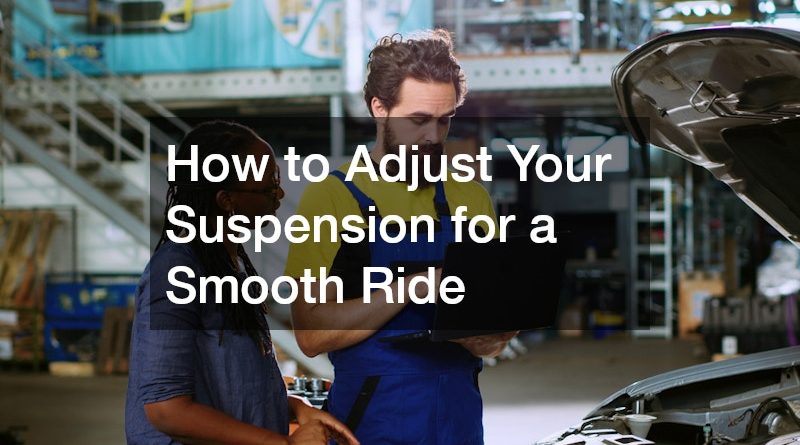How to Adjust Your Suspension for a Smooth Ride
Your suspension is one of the most important systems in your vehicle when it comes to ride comfort, handling and safety. Whether you’re cruising along the coast or dealing with rougher outback terrain, how your car handles the road largely depends on how well this system is set up.
Most drivers don’t think about suspension unless something feels off. Maybe your car bounces more than usual, leans too much into corners or jars you with every bump. If you’ve noticed these signs, adjusting your setup can significantly improve your driving experience.
Understanding the Role of Suspension
Suspension refers to the springs, shocks and linkages that connect your vehicle to the wheels. It’s responsible for absorbing shocks from the road, keeping your tyres in contact with the surface and helping the car stay stable during acceleration, braking and turning.
A well-balanced setup ensures smoother rides, better cornering and reduced wear on other vehicle components. When factory settings no longer suit your driving habits or if you’ve made modifications like bigger tyres or extra load carriers, it’s time to look into making changes.
Signs Your Suspension Needs Attention
Before diving into adjustments, make sure there’s no underlying issue. If your car is bouncing excessively, pulling to one side or the ride feels harsher than normal, you might have worn shock absorbers, uneven tyre wear or a broken spring.
Unusual noises when going over bumps, leaking fluids near the suspension area or visible sagging on one side are clear indicators that something’s not right. If you spot any of these signs, it’s best to have a mechanic inspect the system before attempting adjustments.
Types of Suspension Adjustments
There are several ways you can adjust your suspension, depending on your vehicle type and the level of control it offers. Some cars come with electronically adjustable suspension systems that let you switch between sport and comfort modes at the push of a button. Others may require manual tweaks with spanners and a bit of elbow grease.
Height adjustment is one of the most common modifications. Lowering the car can improve handling and aesthetics, while raising it is useful for off-road clearance. Keep in mind, drastic changes can affect alignment and tyre wear, so adjustments should be made carefully.
Another common adjustment is stiffness, which affects how much the springs compress when driving. Softer suspension offers more comfort on rough roads, while stiffer settings provide better control at high speeds or during cornering. Coilovers and adjustable shocks give you this flexibility, although not all vehicles are equipped with them from the factory.
How to Safely Adjust Your Suspension
If you’re confident in your mechanical skills, adjusting suspension at home is possible, but you’ll need the right tools and safety precautions. Always work on a flat surface and use jack stands to support the vehicle securely. Never rely on a car jack alone.
Start by checking your owner’s manual to understand your vehicle’s suspension setup. If you’re adjusting coilovers, use the supplied spanners to rotate the locking collars and change ride height. For shock absorbers with adjustable damping, turn the dial or knob according to the manufacturer’s instructions.
Make small adjustments and test drive the vehicle after each change. A good rule is to note how the car handles at low and high speeds, how it corners and how it responds to braking. Don’t make all the changes at once or you’ll struggle to isolate what’s helping and what’s not.
When to Call in a Professional
While basic adjustments can be done in the garage, suspension tuning is as much art as science. If you’re aiming for performance handling or want to balance front and rear responses, it’s best to consult a suspension specialist. They’ll have the equipment to check alignment, corner weighting and damping curves with precision.
Professional services are especially important if you’ve recently installed aftermarket suspension parts, changed wheel size or frequently carry varying loads. A specialist can also ensure your adjustments meet legal standards for roadworthiness in Australia, which is something often overlooked during DIY jobs.
Maintaining Your Suspension for Longevity
Once you’ve dialled in your preferred settings, keeping your suspension in top condition should be part of your regular maintenance routine. Check your tyres for uneven wear, monitor your shock absorbers for leaks and book in for wheel alignments after any major adjustments or pothole hits.
It’s also wise to inspect your suspension if you’ve been off-roading or towing heavy loads. Over time, even minor wear can throw off the balance and undo your efforts to fine-tune your setup.
Adjusting your suspension doesn’t have to be complicated, but it does require care, patience and attention to detail. A few small changes can lead to a smoother, more controlled drive and even improve the life of your tyres and other vehicle components.
By understanding what your car needs and knowing when to seek help, you’ll enjoy a better driving experience—no matter where the road takes you.

